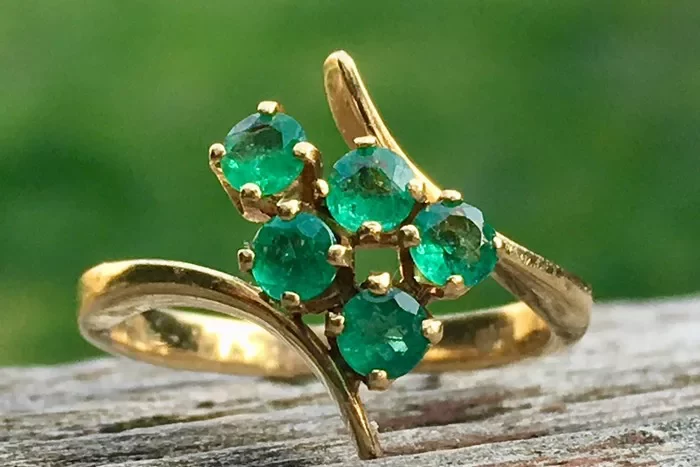The world of gemstones is filled with vibrant colors, fascinating histories, and a multitude of myths. Among these is the notion of “yellow emeralds,” a term that has intrigued both gem enthusiasts and the general public. However, the concept of a yellow emerald is a subject of debate and misunderstanding. In this article, we will delve into the myths and facts surrounding yellow emeralds, providing a clear understanding of what they truly are and the distinctions that set them apart from other gemstones.
What Is an Emerald?
To comprehend the concept of a yellow emerald, it’s essential first to understand what constitutes an emerald. Emeralds are a variety of the mineral beryl, which derives its green color from trace amounts of chromium and sometimes vanadium. The most prized emeralds are deeply saturated with a rich green hue, often with slight blue or yellow undertones, depending on the geographical origin.
Key Fact: The term “emerald” is strictly reserved for green beryl. The defining characteristic of an emerald is its green color, which sets it apart from other beryl varieties.
The Myth of Yellow Emeralds
One of the most persistent myths in gemology is the existence of yellow emeralds. This term is often misleading and can cause confusion among buyers and enthusiasts. The notion of a yellow emerald typically arises from a misunderstanding or misrepresentation of other beryl varieties.
Myth: Yellow emeralds are a unique gemstone variety.
Fact: There is no such thing as a yellow emerald. The term is a misnomer used to describe yellow beryl, more accurately known as heliodor.
Heliodor: The True Yellow Beryl
Heliodor, which means “gift of the sun” in Greek, is the proper name for yellow beryl. This gemstone ranges in color from pale yellow to deep golden hues, caused by trace amounts of iron within the crystal structure. Heliodor is a beautiful gemstone in its own right, but it should not be confused with emeralds.
Key Fact: Heliodor belongs to the same mineral family as emeralds but is distinct due to its yellow coloration, which is fundamentally different from the green hue of emeralds.
Why the Confusion?
The confusion between yellow beryl (heliodor) and emeralds may stem from a desire to market yellow beryl as something more exotic or valuable. Since emeralds are highly prized and often command higher prices, labeling yellow beryl as “yellow emerald” can mislead consumers into believing they are purchasing something more valuable or rare.
Important Note: It’s crucial to verify gemstone identification with a certified gemologist or reputable jeweler to avoid falling victim to such misleading terminology.
The Value of Heliodor
Despite not being an emerald, heliodor is a gemstone of considerable beauty and worth. Its sunny hues can brighten any jewelry collection, and its relative rarity compared to more common gemstones like citrine or yellow sapphire adds to its appeal.
Key Fact: Heliodor’s value is determined by its color, clarity, and cut, much like other gemstones. The most sought-after heliodor stones exhibit a deep, golden-yellow color without visible inclusions.
Marketing Tactics and Misinformation
The gemstone market is rife with marketing tactics designed to attract buyers. The term “yellow emerald” is sometimes used as a marketing ploy to make yellow beryl appear more luxurious. While heliodor is indeed a precious gemstone, it should not be conflated with emeralds, which have a distinctly different color and composition.
Consumer Tip: Always be cautious of gemstones marketed with unconventional or misleading names. Research the gemstone’s true identity and consult with a certified gemologist before making a purchase.
See Also: How Are Emeralds Graded?
Recognizing Authentic Emeralds
Understanding the differences between various beryl gemstones is vital in recognizing authentic emeralds. True emeralds will always exhibit some form of green, whether it’s a vivid forest green or a slightly bluish-green hue. If a gemstone labeled as an emerald shows a yellow hue, it is likely misidentified or mislabeled.
Key Tip: Emeralds with a pure green color are the most valuable. Any significant yellow or blue tint may lower their value and indicates a different variety of beryl.
Common Myths About Yellow Emeralds
Myth 1: Yellow Emeralds Are More Valuable Than Green Emeralds
Fact: This is entirely false. Since yellow emeralds do not exist, the concept of their value is moot. Green emeralds, particularly those with deep, vibrant color and minimal inclusions, are the most valuable.
Myth 2: Yellow Emeralds Are a Rare and Exotic Type of Emerald
Fact: The rarity of yellow emeralds is a myth because they simply do not exist. What some may consider a yellow emerald is actually heliodor, a different gemstone altogether.
Myth 3: Yellow Beryl Can Be Marketed as Yellow Emerald
Fact: While yellow beryl (heliodor) is a legitimate gemstone, marketing it as yellow emerald is misleading and incorrect. It is essential to label gemstones accurately to avoid consumer deception.
The Importance of Proper Gemstone Identification
Accurate gemstone identification is crucial in the world of gemology. Misidentification can lead to misunderstandings about a gemstone’s value, rarity, and even its origin. Professional gemologists use various tools and techniques to identify gemstones, including spectrometry, refractometry, and microscopic examination.
Pro Tip: When purchasing gemstones, always request a certificate of authenticity from a recognized gemological laboratory. This certificate will confirm the gemstone’s identity and provide details about its quality and characteristics.
Conclusion
In conclusion, the concept of a yellow emerald is a myth that has been perpetuated through misinformation and marketing tactics. The reality is that emeralds are green, and any beryl gemstone that appears yellow is correctly classified as heliodor. Understanding this distinction is essential for anyone interested in gemstones, whether as a buyer, collector, or enthusiast.
By debunking the myth of yellow emeralds and embracing the true beauty of heliodor, you can make informed decisions when purchasing gemstones and appreciate the unique qualities of each variety. Always seek the advice of certified gemologists and rely on trusted sources for your gemstone purchases to ensure you are getting exactly what you pay for.


